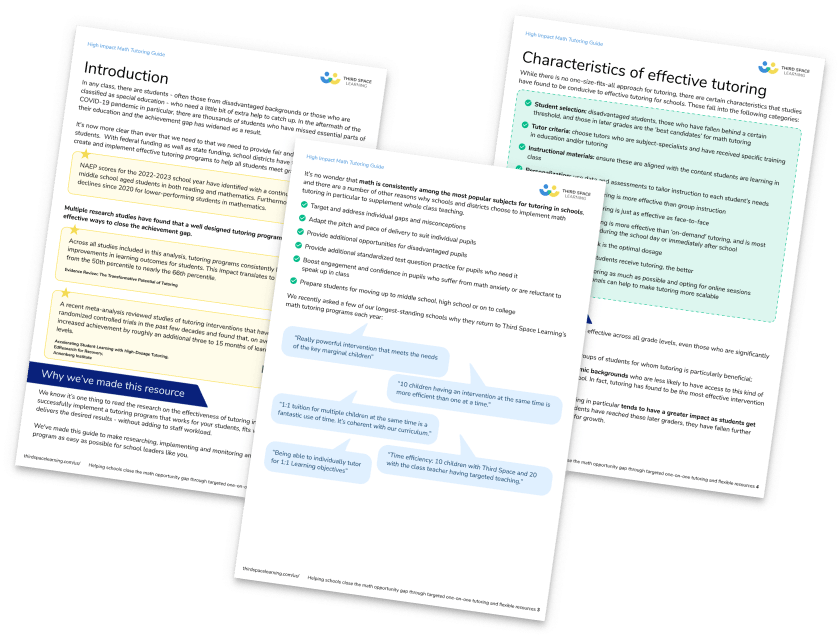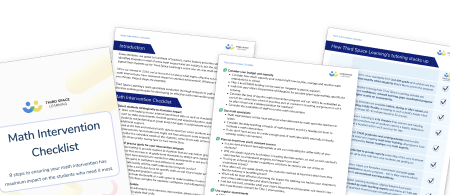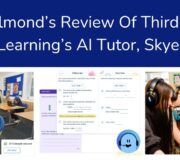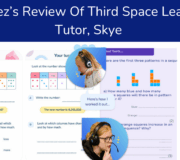Voice-Based AI Math Tutoring vs. Text-Based: Why Conversation Matters For Math Progress
AI tutoring can be a promising solution for school leaders facing limited budgets and stretched resources, particularly when tackling learning gaps in math. But how students interact with their AI math tutor – either voice or text-based communication – can significantly impact their learning outcomes, particularly in mathematics. If the AI tutor can’t hear students explain their thinking, it may miss the most important part of math learning.
This article explores how voice-based AI tutoring offers advantages over more widely recognized text-based alternatives for math instruction. It examines the research-backed benefits and real-world applications helping schools provide affordable, personalized learning at scale.
Understanding the different approaches to AI tutoring
Artificial intelligence (AI) in education may seem like a relatively new concept, but it can be traced back as far as the 1960s. Today, AI has been used to develop intelligent tutoring systems (ITS) so they can deliver adaptive and personalized learning in classrooms.
Originally, AI tutors used text-based communication to provide support to learners in the form of generated questions and marking answers right or wrong. However, advancements in AI and large language models (LLMs) are enabling the development of personalized voice-based AI.
While voice-based AI is not new – automated voice messages have existed for many years – these advancements make it possible to provide real-time voice-based AI tutoring in education.
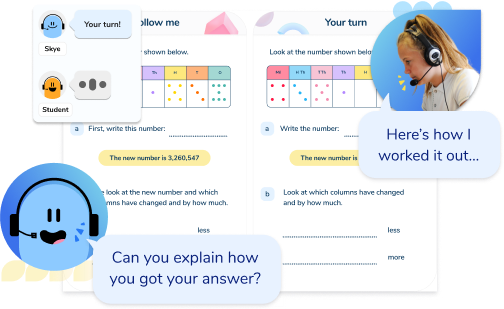
Book a free AI math tutoring pilot for up to 20 of your students.
See how unlimited one-on-one high-dosage math tutoring can support your school or district and boost students’ math achievement.
Developed by math teachers, trusted by 4,100+ schools, and counting.
Book a free pilotWhat is voice-based AI tutoring?
Voice-based AI tutoring, or conversational AI tutoring, is an intelligent tutoring system (ITS) that delivers a form of online tutoring by creating a dialogue between the student and the artificial intelligence through spoken interaction. It combines:
- Automatic speech recognition (ASR) to understand what students say
- Natural language understanding to interpret meaning and context
- Adaptive pedagogical strategies to respond appropriately
- Speech synthesis to deliver verbal feedback and instruction
Voice-based tutors like Third Space Learning’s Skye enable students to explain their mathematical thinking aloud, just as they would with a traditional human tutor. The AI listens, analyzes the response, and provides immediate verbal feedback tailored to the student’s needs.
READ MORE:
- From Traditional Tutoring to AI Tutoring: Helping More Students Catch Up in Math
- AI Policy for Schools: Step-by-Step Guide To Developing An Effective AI Policy
- 5 Ways Schools Are Using AI Tutoring
- Supercharge Your Math Teaching with ChatGPT & LLMs: Prompts, Tips, and Pitfalls
- Intelligent Tutoring Systems: 7 Research-Backed Principles for Building an Effective AI Tutor
What is text-based AI tutoring?
Unlike conversational AI tutors, text or chat-based AI tutoring relies on written communication between the student and the ITS. Students read questions or prompts, type their responses, and receive written feedback. While these systems have improved significantly in recent years, they still operate primarily through:
- Written prompts and questions are presented on screen
- Typed student responses
- Text-based feedback and hints
- Sequential interaction that follows a more rigid pattern
Text-based systems often focus more on providing correct answers rather than developing mathematical thinking processes, problem solving and reasoning, with interactions that feel less conversational and more transactional.
While text-based tutoring systems have improved significantly, they still face inherent limitations in math education, where explaining step-by-step reasoning verbally often leads to deeper understanding than typing answers.
Math Intervention Checklist
Essential step-by-step checklist to help you select, manage and evaluate the best math intervention programs for your students
Download Free Now!Skye: voice-based AI math tutoring in practice
Third Space Learning’s math experts and teachers developed Skye, a voice-based AI math tutor, using the same pedagogical principles, effective teaching strategies, and curriculum-aligned lessons as traditional, human-led tutoring.
67% of middle and high school students are already using AI tools in education. But what sets Skye apart is the application of expert insights from over 2 million one-to-one online tutoring sessions delivered to more than 170,000 students across 4,000 schools. The most effective AI tutoring is built on human expertise.
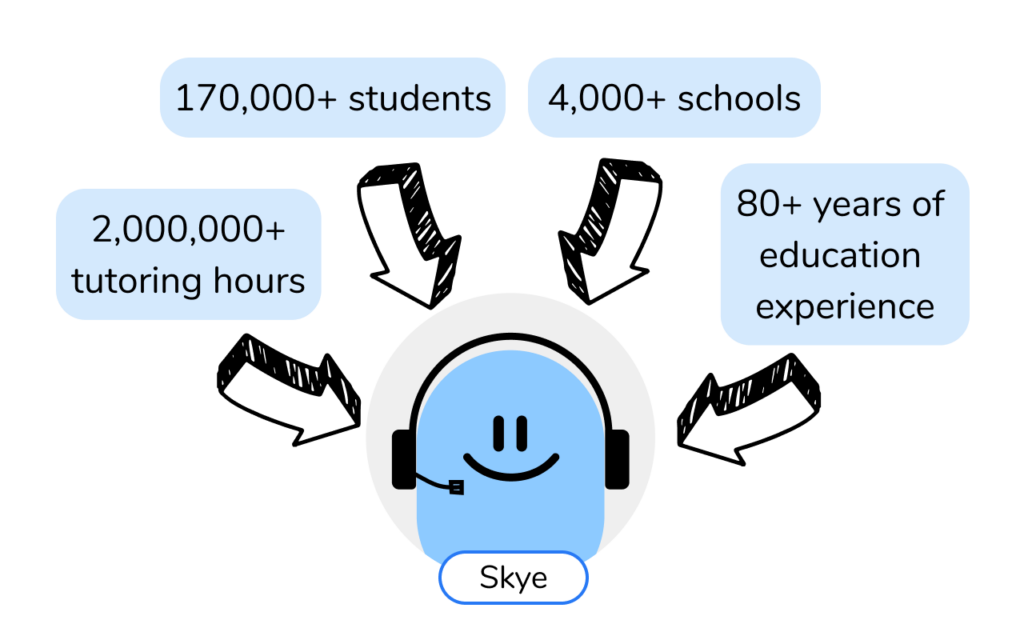
Skye follows seven principles of effective AI math tutoring identified by education researchers:
- Comprehensive curriculum crafted by experts: Qualified math teachers design all Skye’s lessons. Nothing is generated by AI, ensuring accuracy and pedagogical soundness.
- Scaffolded learning with gradual hints: Skye follows the “I do, we do, you do” approach. Instead of giving the right answer, it offers up to three targeted hints to address misconceptions.
- Active recall and spaced repetition: Skye is built on a spiral curriculum, with regular retrieval practice to reinforce long-term memory.
- Interleaving for enhanced understanding: Each lesson includes various question types and connections between math concepts.
- Structured challenge problems: Every lesson includes multi-step challenges to promote reasoning and deeper thinking.
- Reflective feedback: Skye is trained to understand correct ideas, not just correct answers. It encourages articulation of reasoning.
- Cognitive load management: Lessons take cognitive load theory into consideration and are broken into small, manageable steps with a simplified interface and selective blurring.
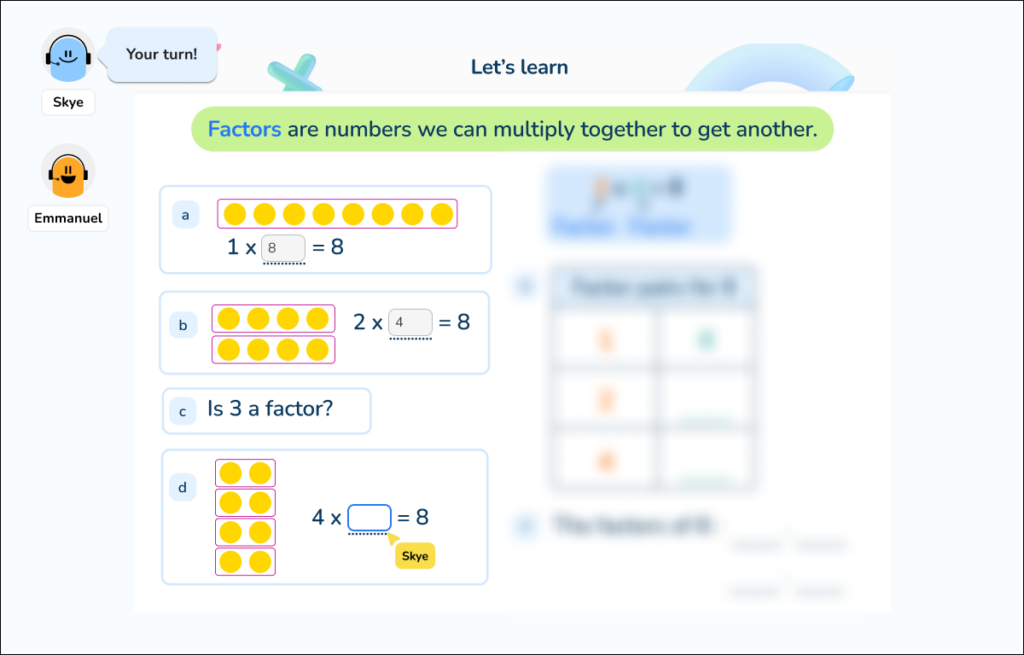
Voice vs text: 11 educational advantages of voice-based AI tutoring in maths
1. Verbalization improves mathematical reasoning
Voice-based AI tutoring: When learners talk through problems, they articulate their thought process, strengthening neural connections to make reasoning clearer and easier to recall. Verbalisation also helps the AI tutor to identify math misconceptions immediately.
The Education Endowment Foundation (EEF) found that when students explain their mathematical thinking aloud, they engage in metacognitive processes that help consolidate understanding.
For example, when a student verbally reasons how to convert a fraction to a decimal, they must articulate each step, e.g. \frac{3}{4} to 0.75, “I need to divide 3 by 4, which gives me 0.75.”
Skye prompts students to explain their thinking aloud by asking open-ended questions such as, ‘How did you work that out?’ This verbal articulation of mathematical processes helps deepen understanding and identify misconceptions immediately.
Text-based AI tutoring: Students often give brief answers without providing the reasoning behind them. A lot of typing can discourage thorough explanations.
2. Reduces mathematical cognitive load
Voice-based AI tutoring: When students engage in mathematical discussions, they use a different cognitive process from typing. Students can focus entirely on mathematical thinking without the added cognitive burden of reading complex instructions and formulating written responses.
For example, when solving a complex problem about calculating the area of a compound shape, students can concentrate solely on the mathematical reasoning rather than how to express it in writing. Skye presents one idea at a time, using screen blur, highlight and pointing tools to guide focus and reduce cognitive load.
Text-based AI tutoring: Students have to divide their cognitive resources between decoding text, formulating written responses, and solving mathematical problems. This split attention reduces capacity for mathematical thinking.
3. Removes literacy barriers to math
Voice-based AI tutoring: Takes away reading and writing barriers, allowing students to engage with mathematical concepts regardless of their reading or writing abilities.
For example, younger students or those with special education needs such as dyslexia can understand and solve complex mathematical problems without needing to read word problems or write detailed explanations.
Based on our experience delivering online tutoring for special education students, Skye uses carefully tested, age-appropriate mathematical language. If students don’t understand a question, Skye can rephrase instructions using simpler language while maintaining mathematical accuracy.
Text-based AI tutoring: Places high demand on reading fluency and writing skills. Students with limited literacy, including English Language Learner (ELL) students, may struggle to access math through text.
4. Adaptive math support through dialogue
Voice-based AI tutoring: Can detect nuances such as hesitation, confusion, or uncertainty and adjust responses accordingly, providing the right level of help.
For example, when a student struggles to explain how to solve an equation like 2x + 3 = 7, the tutor can hear uncertainty and provide appropriate guidance on that specific step.
Skye provides scaffolded hints in three steps:
- Gentle prompt
- More direct hint
- Complete explanation, if needed
Text-based AI tutoring: Misses nuances and relies solely on written responses to gauge understanding, lacking vocal cues that indicate confusion. This limitation makes it harder to provide the appropriate support.
5. Creates engaging and authentic learning experiences
Voice-based AI tutoring: Mimics the natural back-and-forth of human conversation, creating a presence that many students find more engaging and supportive.
For example, the tutor can use an encouraging tone when a student correctly identifies that the area of a triangle is ½ × base × height, reinforcing positive learning experiences.
“Today, we’re thrilled to be at the forefront of using Third Space Learning’s AI voice tutoring. The students are thoroughly enjoying the experience, and their engagement and focus are clearly evident.”
Chris Harris, Assistant Principal, Admirals Academy
Text-based AI tutoring: Often lacks conversational quality, with interactions feeling more mechanical and less personally engaging. The absence of real-time, encouraging dialogue can make the experience feel less supportive.
6. Builds math confidence and reduces anxiety
Voice-based AI tutoring: Creates a safe learning environment where students can focus on math without worrying about spelling, grammar, or typing skills.
For example, a student who normally feels anxious about written work can confidently explain verbally why 3² = 9 without worrying about how to format the explanation correctly in writing.
“Third Space Learning’s voice-based AI tutoring has reinvigorated some of our most reluctant learners. They are so excited that they ask their teacher to leave class a bit early so that they can get started.”
Ryan Lucas, Principal
Governor’s Ranch
Text-based AI tutoring: May create additional anxiety for students who struggle with writing or spelling, potentially causing them to limit their responses or avoid fully expressing their mathematical thinking.
7. Easier to support more students simultaneously
Voice-based AI tutoring: Enables schools to provide personalized math support to many students simultaneously without needing additional staff members or resources.
For example, a school could run 30 simultaneous one-to-one tutoring sessions with just one staff member supervising, allowing many students to receive personalized support.
Skye tutoring is unlimited, meaning you can run as many sessions for as many 3rd – 8th graders as need it for just one low fixed cost per school.
“This innovative one-to-one math tutoring solution offers an even more cost-effective alternative.”
Chris Harris, Assistant Principal
Admirals Academy
Text-based AI tutoring: While it can also operate at scale, it often requires more teacher intervention to address misunderstandings not captured in the text-based interaction. This limits its scalability.
8. Develops mathematical language
Voice-based AI tutoring: Demonstrates and helps students internalize and practice correct mathematical vocabulary through spoken dialogue.
For example, if a student refers to the top part of a fraction, the voice-based AI tutor can repeat the sentence using the correct terminology: numerator.
Text-based AI tutoring: Typically provides fewer opportunities to model and reinforce mathematical language in real time, leading to slower development of precise vocabulary.
9. Real-time formative assessment
Voice-based AI tutoring: Allows tutors to instantly assess understanding through tone, language, and explanation, adapting instruction on the spot.
For example, if a student incorrectly says, “I multiplied both sides by 2,” rather than dividing, the tutor can adapt the tutoring to address the misconception or mistake. It might clarify: “Think again – what’s the opposite of multiplying?”
This rapid, responsive feedback loop enhances learning and minimizes the persistence of misconceptions.
Skye understands when students are hesitant and when they have misconceptions. It then provides scaffolded support to address the misconception and build confidence.
Text-based AI tutoring: Cannot interpret tone or spontaneous verbal reasoning, often requiring delayed clarification or follow-up from teachers.
10. Inclusive of ELL learners
Voice-based AI tutoring: Provides flexible support through real-time speech for students with English language learners (ELL) or neurodiverse profiles, reducing language and processing barriers.
For example, if an ELL student is confused by “subtract,” the tutor can rephrase: “That means to take away. Can you try again?”
When students don’t understand the question or instruction, Skye can rephrase it.
Text-based AI tutoring: Often provides static instructions or feedback, which can be harder for ELL and neurodiverse learners to decode.
11. Reinforces working memory
Voice-based AI tutoring: Engages working memory by allowing students to hear and say mathematical concepts aloud, strengthening retention.
This method supports dual-channel learning, combining auditory and visual inputs, which is particularly helpful for younger students or those with working memory challenges.
Every Skye session includes visual lesson slides to support the learning objective. Students can reference the slides while listening and responding to Skye to reinforce mathematical concepts.

Text-based AI tutoring: Primarily engages visual processing and doesn’t activate auditory learning pathways, limiting reinforcement through spoken repetition.
Ensuring safety and accountability in AI tutoring
Whether AI tutoring is delivered through voice or text, when it comes to any use of AI in the classroom, student safety must remain a top priority. Both formats involve student interactions with a digital system.
This means developing a clear AI tutoring policy and oversight process is essential to keep students safe and ensure accountability.
For both voice-based and text-based AI tutoring tools, schools should ensure that:
- Sessions are scheduled and supervised by authorized staff
- Conversations are recorded or logged
- Any concerns are quickly flagged and escalated when necessary
- There is an AI policy in place covering the use of all AI in education
Unlike many chat tools that rely on unmonitored written exchanges, Skye, the voice-based AI math tutor, records all audio interactions, making it easy to monitor and flag concerns.
Red flags are automatically recorded, reviewed, and escalated, when appropriate, by a member of the Third Space Learning team. They are categorized from 1 (most severe) to 5 (least severe):
- Safety concern
- Severe disruptive behavior
- Student distress
- Mild disruptive behavior
- Student frustration
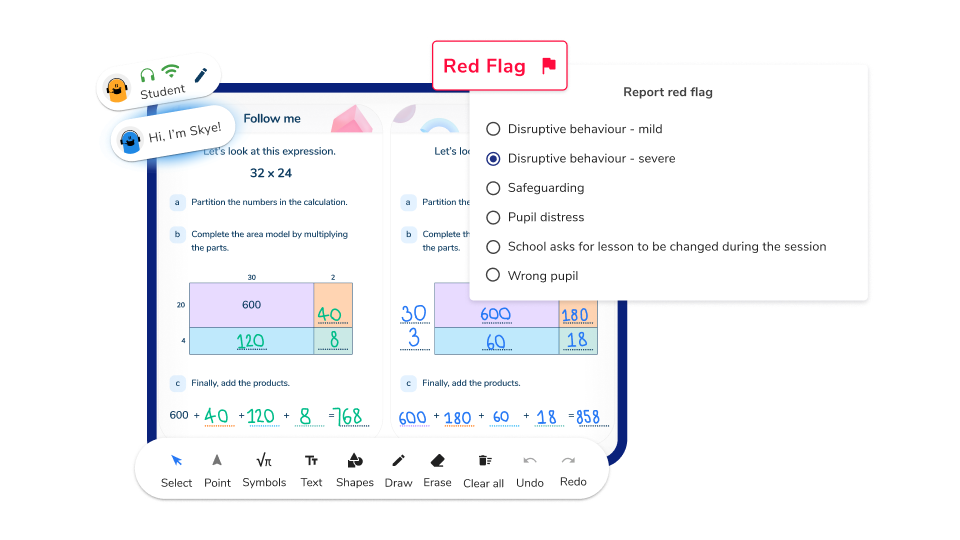
Implementing voice-based AI tutoring in schools
For schools considering voice-based AI tutoring, here’s a practical implementation roadmap:
- Assess technology: Ensure you have a reliable internet connection, appropriate devices, and headsets with microphones for each student.
For Skye, you only need basic equipment that most schools already have. - Identify target students: Determine which students would benefit most from extra math support via a voice-based AI math tutor.
Schools currently using Skye support between 16-120 weekly sessions. - Schedule tutoring sessions: Allocate specific time slots for additional math tutoring that fit into the school day.
With Skye, you can schedule sessions at 5-minute intervals before, during, or after school hours, meaning you can integrate tutoring into your existing timetable seamlessly. - Prepare quiet learning spaces: Voice-based tutoring requires a space where students can speak aloud without distractions.
Many schools using Skye opt to use hallways, breakout rooms, or library corners, as well as dedicated spaces such as computer labs. - Train supervising staff: Ensure staff understand how to oversee multiple sessions simultaneously.
Skye offers an “observe session” feature allowing staff to join any live session as a muted observer to check progress or assist with technical issues. - Set clear learning goals: All voice-based AI tutoring sessions must align with curriculum objectives. Diagnostic assessments help identify each student’s knowledge gaps.
With Skye, teachers can reorder lessons to prioritize these gaps or align with classroom teaching. - Monitor and evaluate: Regularly review progress and adjust implementation as needed.
Schools can track student attendance, engagement, and progress through detailed session reports.
Early data shows students perform better on post-session questions with Skye, and attendance is higher due to increased flexibility. - Safeguarding considerations: Ensure your AI tutoring policy addresses student safety and data protection requirements.
Skye records all sessions and automatically flags potential student safety concerns, categorizing them in order of severity.
The future of personalized AI math support
Voice-based AI tutoring offers a more effective solution for extra math support than text-based alternatives. Conversational AI for math tutors encourage students to verbalize their reasoning and problem-solving. This helps the tutor identify and address misconceptions in real time, just as a teacher would in class.
Verbal communication allows for immediate and personalized feedback in the same way traditional one-on-one tutoring does. This supports reasoning, focus, and confidence in ways that short, typed answers can’t match.
For schools looking to provide high-quality math support at scale, voice-based AI tutoring combines the best teaching strategies with the consistency and availability of technology. It makes personalized learning accessible to every student who needs it, without compromising on safety, oversight, or teaching standards. Interested in how AI can enhance math teaching beyond tutoring? Read about the best AI for math here.
FAQs
A chatbot is text-based and communicates with people using text. Users type messages and receive written responses through interfaces like websites, messaging apps, or SMS. A voice bot communicates with people using spoken dialogue. They use speech recognition to understand spoken commands and natural language processing to generate spoken responses.
AI is the whole field or category of artificial intelligence focused on creating machines or systems that can perform tasks typically requiring human intelligence. Conversational AI is a specialised subset of AI designed to enable human-like interactions through natural language.
Do you have students who need extra support in math?
Skye—our AI math tutor built by experienced teachers—provides students with personalized one-on-one, spoken instruction that helps them master concepts, close skill gaps, and gain confidence.
Since 2013, we’ve delivered over 2 million hours of math lessons to more than 170,000 students, guiding them toward higher math achievement.
Discover how our AI math tutoring can boost student success, or see how our math programs can support your school’s goals:
– 3rd grade tutoring
– 4th grade tutoring
– 5th grade tutoring
– 6th grade tutoring
– 7th grade tutoring
– 8th grade tutoring
